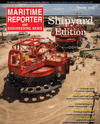
Page 58: of Maritime Reporter Magazine (August 2013)
Shipyard Edition
Read this page in Pdf, Flash or Html5 edition of August 2013 Maritime Reporter Magazine
58 Maritime Reporter & Engineering News ? AUGUST 2013 While there are indications that the shipping indus-try is starting to emerge from the doldrums of the last six years, signals remain mixed. Moore Stephens reported in June that shipping conÞ dence has risen to its highest point since 2010. Indeed, there are signs of a new wave of speculative ordering of new tonnage, propelled by bargain-basement prices from shipyards desperate to Þ ll slots and a reported inß ux of capital from private equity sources. A primary driver for the surge of orders is the improvements in fuel ef-Þ ciency of new ship designs over older ships. On the other hand, in the same month, Moody?s Investor Service issued a negative report for shipping, predicting continued depressed freight rates for at least the next 18 months due to persistent over tonnage in most segments. Moody?s estimates that aggregate industry Earn-ings Before Income Tax, Depreciation and Amortization (EBITDA) for public- ly held shipping companies will decline by 5-10% this year. The mix of anemic shipping demand, over tonnage, low freight rates, ris-ing fuel costs, tight credit from marine bankers and high costs of environmen-tal compliance to meet new regulations makes for a poisonous cocktail to ship-owners. The fall into receivership of STX Pan Ocean, South Korea?s largest bulk ship operator, is a sign of the times. It?s not likely to be the last. Several other shipowners are said to be insolvent and teetering on the verge of bankruptcy. In- terestingly, there are reports that certain German banks are offering high-interest ?payday loans? against the scrap value of older vessels as a last resort for dis-tressed ship owners who have exhausted their working capital and are unable to obtain Þ nancing to continue operations. The delivery of the Þ rst Maersk gi- ant Triple E 18,000-teu containership, coupled with rumors that other container lines are designing even larger ships, into a market already overcrowded with too many ships chasing too few cargos, may be a big gamble that will pay off enormously in terms of market share, but will certainly not help ease the persistent over tonnage. The crystal ball may be murky, but one thing is clear. Shipown- ers must reduce the cost of operating ships to survive in the coming years. The Þ rst place to start is with fuel, which accounts for 40-50% of a vessel?s operating costs. As the Emission Control Areas (ECA) continue to expand, that percentage is likely to rise even higher due to the higher cost of low-sulfur fu-els. Ship owners have adopted numerous methodologies to reduce fuel consump-tion, such as slow steaming, advanced hull coatings, better weather routing and asset management strategies, which have yielded notable beneÞ ts. Shipowners are increasingly looking to alternative fuels or hybrid propulsion systems to reduce their rising fuel bills. LiqueÞ ed natural gas (LNG) offers considerable bene Þ ts over other fuels meeting the ECA re- quirements for reduced emissions.Focus on LNGLNG as a marine fuel is still in the early developmental stages. At the be-ginning of the year, it was reported that there were 37 LNG-powered vessels in operation (not including dedicated LNG carriers that use ?boil-off? gas for ship propulsion). That number will rise to 65 in the next few years based on cur- rent orders. A recent DnV study projects 1,000 LNG-fueled ships to be in service by 2020. Most of the current LNG- pow-ered ships are ferries and short-sea car- riers, operating on relatively short Þ xed routes in regions where LNG bunkering is readily available, mostly in Scandi-navia. The potential bene Þ ts from LNG are impressive. LNG can reduce SOx emissions by 90-95% and CO2 by 25%, according to industry estimates. In the U.S. market, LNG currently sells for about one half the price of other ECA-compliant fuels. There?s plentiful supply of untapped LNG deposits that are now being developed, especially in America, Russia, Qatar and Australia. Even after the increased costs of extracting, trans-porting, storing and bunkering LNG are factored into the equation, LNG will al-most certainly continue to maintain an attractive price advantage over conven-tional marine fuels. On the other hand, it is more expen-sive to build new LNG-fueled ships or to convert existing ships. One study esti-mates the cost for a new LNG-powered ship to be about 20-25% higher than an equivalent vessel with traditional fuels. Payback periods for conversion to LNG are said to be three to seven years. This analysis is based on the assumption of an adequate LNG bunkering infrastructure in place at ship sailing ports. Barriers to EntryThere lies the rub. The biggest bar- rier for widespread adoption of LNG at this stage is the lack of a worldwide bunkering infrastructure. Other inhib-iting factors for LNG include a lack of LNG-speciÞ c training for shore and ship-based staff, as well as the absence of international standards for bunkering with LNG. There are also concerns about methane burnoff during bunkering, caus- ing CO2 release into the atmosphere and increased engine knocking from varying methane number in LNG fuels.Despite the challenges, a number of forward-looking shipowners are already placing their bets on LNG. Tote, Inc. rocked the industry when it announced it COLUMNEVENTSReducing Ship Operating Costs TOTE, NASSCO and MAN Diesel & Turbo are leading the way to- wards big commercial ship in- tegration of LNG as fuel.By Jim Rhodes and Frank SoccoliRhodes is president of Rhodes Communications, Inc., a public relations and marketing company special-izing in the maritime industry. Soccoli is president of Socco- li Associates LLC, a maritime industry consultancy. They are the co-producers of the annual SHIPPINGInsight Fleet Optimization Conferences. MR #8 (58-65).indd 58MR #8 (58-65).indd 588/1/2013 2:47:46 PM8/1/2013 2:47:46 PM

 57
57

 59
59
